Movie: Look Who’s Back – Hitler is back in 2012 …. Best selling Book
[I read this article from The Occidental Observer with great interest. Has anyone seen the movie? Is it worth watching? It does indeed seem quite interesting and it has a number of twists. I think some interesting and valid messages were sent like saying that you can't get rid of Hitler because Hitler is a part of Germany and a part of Germans. It is also correct for it to portray those who voted for him as normal people. There was nothing "wrong" with them. All the screeching and howling about Hitler comes from JEWS … and JEWS want everyone to believe that he was evil, which he was not. He was a very clever, very sane, indeed, brilliant man. I'm delighted that the novel became a best seller in Germany. Very nice. And I like the ending … with Hitler saying "I can work with this." Rest assured, NEW HITLERS ARE NEEDED. Spengler predicted the rise of Caesars after the year 2000. I think so. We most definitely need strong White male leaders to seize back the Western world. Jan]
Look Who’s Back is the English title for a German movie released in October of 2015. Dealing with the hypothetical return of Adolf Hitler in contemporary Germany, the film, based on a 2012 novel, was quite successful. While the movie reached the number one rank in Germany in the third week after its release, the book has sold over 1.4 million copies and has been translated into at least 41 languages.
After being mysteriously transported to the former site of his bunker in modern-day Germany, the Führer is taken for a comedian, quickly attracting a television role and many admirers. He expresses contempt for much of contemporary German society, including television and most political parties, although he sympathizes with the Green party out of a typical German love of the natural world.
Watching this film, it is hard not to come to the conclusion that it is not so bad to think or do something that Hitler would approve of. Not only nationalism and world domination, but also courage, nature, and Wikipedia are relevant to his interests. After embarrassing himself by shooting a small dog, Hitler even makes a donation to the cause of animal protection, another interest of the historical National Socialists. All this helps circumvent the modern fad of relating everything not politically correct to Hitler in an attempt to end discussion.
The author seems to agree that having something in common with Hitler is no cause for panic. In an interview in the Sydney Morning Herald he makes it clear that he believes existing depictions of Hitler are unrealistic. Hitler is portrayed elsewhere as either a monster or “the funny Hitler,” but “Most people wouldn’t think it possible that if they would have lived back then, they would have thought he was in some way attractive too.” One reviewer agreed that historical facts might be obscured by considering Hitler “either as a comic figure or as the incarnation of evil.”
Timur Vermes, the author of both the book and the script for the film, apparently had a sense of humor in that he priced the book at €19.33, a reference to the year of Hitler’s ascent to power. This was a response to his publisher’s suggestion of €19.45; he preferred to grant the work a lighter tone by referring a point in history when, as he put it, “you have some hint that maybe it could have ended better.”
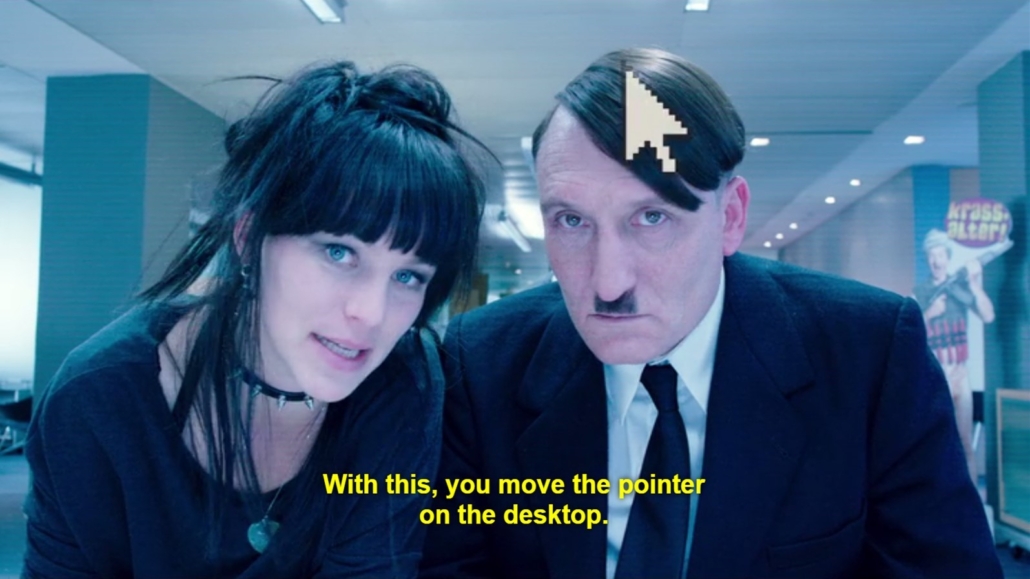
The secretary Krömeier instructs Hitler in the use of computers.
While most Germans believe or at least hope that they would have been strongly opposed to Hitler had they been alive at the time, the film suggests otherwise. Not only are normal people impressed with him, but the people most hostile to Hitler are not exactly cast in a positive light. These include not only the conniving TV executive Sensebrink, at least initially, but also an old Jewish woman with dementia, as well as a freelance journalist with a severe case of cuckface. The latter, one Sawatzki, is the first to discover Hitler and initially sees him as a great opportunity.
Hitler is not impressed by what passes for “neo-Nazism” in modern-day Germany, including street protesters, vegan cooks, and officers of an unsuccessful nationalist party called the NPD (National Democratic Party of Germany). Far from being able to construct the Fourth Reich, he remarks, “they can’t even build an Ikea shelf.”
Contemporary “Nazis” do not all think highly of the new Hitler either, although many express sympathy; two thugs ultimately assault and severely beat the Führer, not realizing his identity. In a reference to the National Socialist explanation for the loss of World War I, they accuse him of stabbing Germany in the back.

Krömeier’s grandmother makes reference to family killed in the Holocaust and screams at Hitler.
The newer and more prominent nationalist party Alternative für Deutschland (AfD) is depicted, but not to tar them as pro-Hitler. The Führer is interested enough to meet with them, and their representative is portrayed complaining about the media characterizing the party as right-wing while Hitler himself is resting his head on his shoulder. However, rather than approving of them, he is sleeping because he finds their platform so boring.
Some scenes may have been attempts to make those who share Hitler’s concerns about immigration look ignorant. One man believes that the average IQ of African immigrants to Germany is between 40 and 50 and that the overall average IQ of his country has already dropped below 80. The actual average IQ in sub-Saharan Africa is estimated at between 67 and 82, although this is of course still far below the German average of about 102.
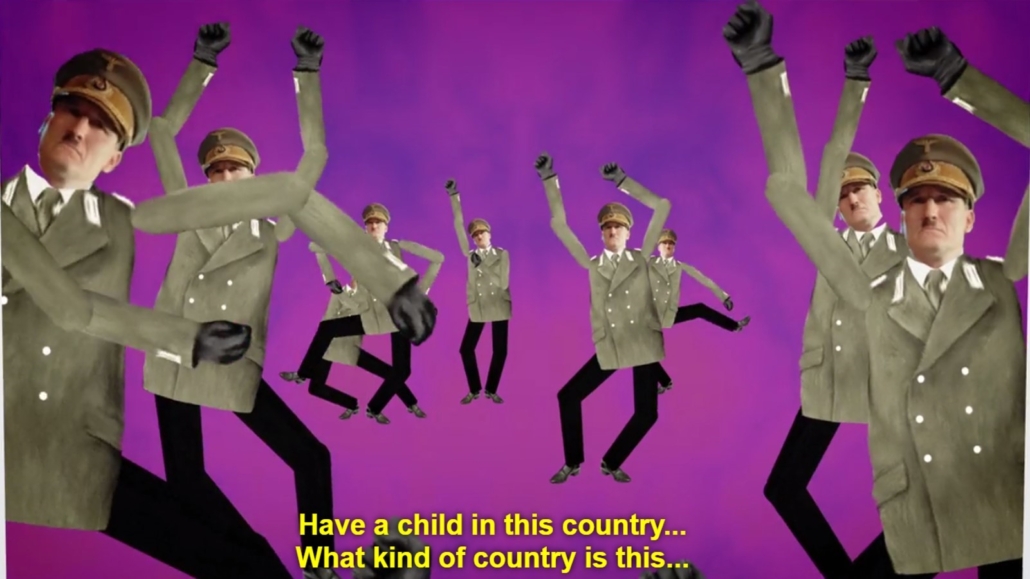
A video on YouTube features a song made from Hitler’s televised speeches.
For the most part, though, it is easy to agree with what Hitler and his new fans say about politics and society. Is being concerned about unemployment, cultural degeneration and a declining population objectionable or even unusual? His comments denouncing various social ills resonate with viewers, inspiring YouTube videos including “songified” speeches and dancing Hitlers.
Much of this movie is actually unscripted; the actor playing Hitler is interacting with typical Germans on the street. Many are happy to be associated with him, and some even give Roman salutes.

Miss Krömeier is excited when the Führer demands a proper greeting rather than being called “mister.”
Many women in the film obviously find Hitler exciting, including several of the non-actors as well as the scripted characters. Both the television executive Bellini and the young secretary Krömeier clearly demonstrate this. Upon first encountering Hitler, the younger woman is overjoyed at the opportunity to play a role and gives an enthusiastic Roman salute, complete with shouting. In contrast with Krömeier’s “good morning, my Führer,” one girl on the street greets Hitler with “may I hug you?”
The Führer is of course depicted as having flaws. He is quick to anger, and he even shoots an attacking dog which is too small to pose a real threat. After touching an electric fence as part of a courage-building effort with Sawatzki, he tries to deny that it hurts despite his obvious physical reaction to the shock. A similar hint of dishonesty is shown when Hitler tells Bellini that he inflated the numbers of an organization he founded, starting the count of German Worker’s Party members at 500 rather than one.
Hitler’s hatred for the Jews would of course be considered a more serious flaw by most contemporary Germans, and the matter is not omitted, but it is a relief that it is far from the focus of the film. He even tries to restrain it somewhat, speculating that although Miss Krömeier’s grandmother is Jewish, she herself may not be a pureblood Judin. This brings us the interesting phrase “the body can handle a certain amount of Jewishness.”

Hitler uses a slain dog as a prop for a joke to lighten up the drive.
Hitler also has a sense of humor, at times more so than Sawatzki. After Sawatzki tries to convince him that the word “nigga” blaring from his car stereo now means “friend,” Hitler decides to practice this new meaning of the word. He picks up the carcass of the dog he has just killed, holds it toward the journalist, and says “hey, nigga!” He even has the dog kiss Sawatzki, which despite being a lonely single man he does not appreciate.
There is an interesting statement here on the absurdity of the fantasy of going back in time and assassinating Hitler before his rise to power. In a sequence near the end of the film, Adolf is brought at gunpoint to a rooftop by a crazed Sawatzki, who has discovered that the “comedian” is the dictator himself.
Hitler is permitted to make a point here in response to Sawatzki’s accusation that “you are fooling people with your propaganda.” The Germans who voted for Hitler were not simply fooled by clever rhetoric, he explains. Instead they knowingly chose a leader who reflected their values.
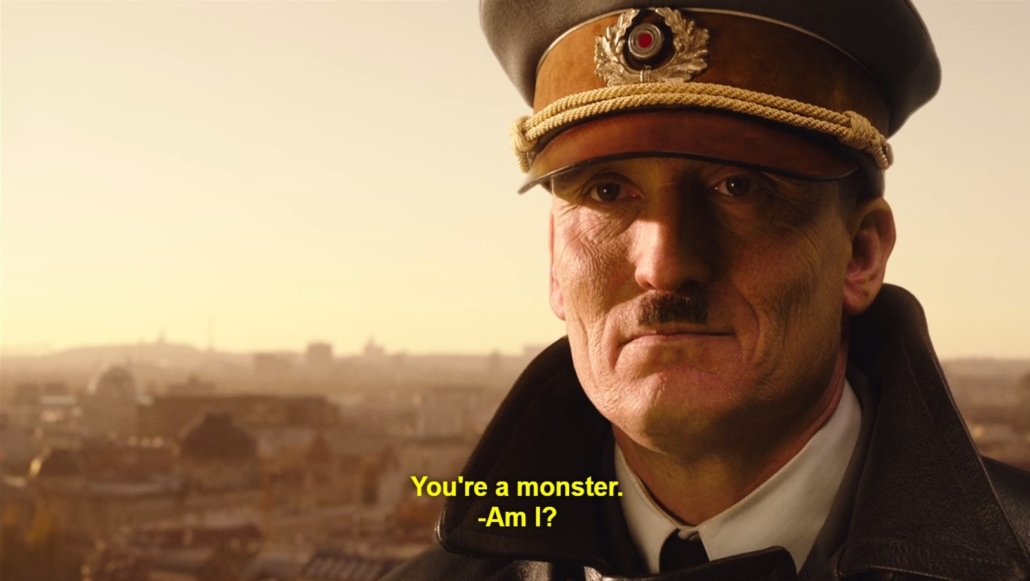
In a movie based on his latest book, Hitler faces death at the hands of Sawatzki.
On the rooftop, the Führer responds to being called a monster by calmly uttering words to the effect of “if you condemn me as a monster, do you condemn all those who voted for me? They were ordinary people.”
What seems to be the end of the Führer, with a shaking “Sawatzki” shooting him in the face, turns out to be only a scene played by an actor in a silicone mask. Hitler has written a wildly popular new book, inspiring a movie in which he plays himself. This is the only point at which he seems to be defeated. He is confident that he will not be shot and displays a comical surprise when he is, as if to fulfill a fantasy of finally humiliating someone who seems untouchable.
However, Adolf inexplicably returns after his fallen body disappears, informing Sawatzki that Germans will never be rid of him. He represented something much greater than himself; as he puts it, he was “a part of all of you.”
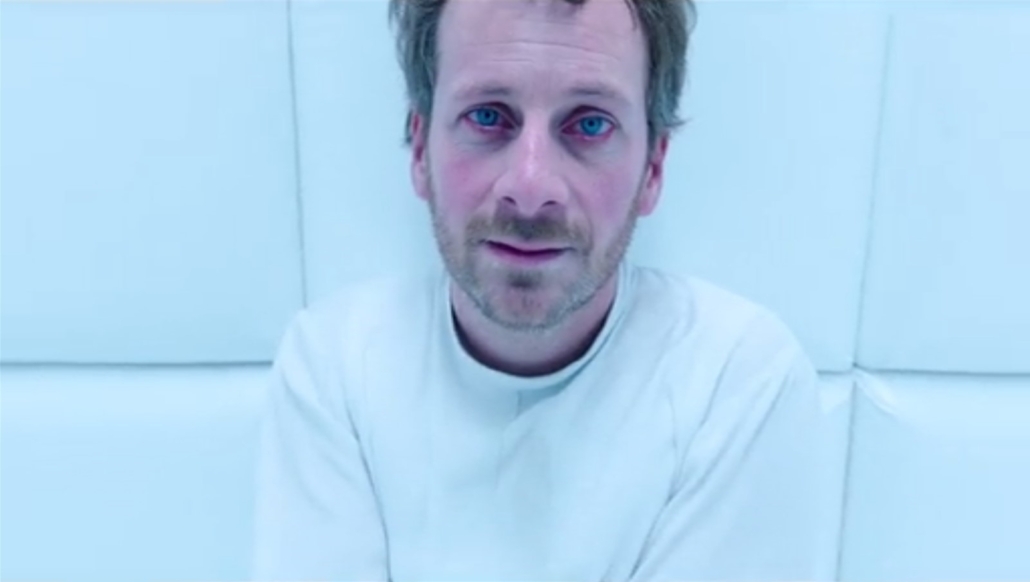
Sawatzki is kept in a padded cell after an outburst concerning “comedian” Hitler’s true identity.
A further condemnation of the idea of assassinating Hitler is that the man who “kills” him is deemed insane. Attempting to convey the new celebrity’s true identity to Bellini in a violent outburst, the real Sawatzki attracts the attention of hospital staff and ends up in a mental asylum.
Near the end of the film Bellini is riding in a Mercedes with the Führer and a journalist asks her if she fears the rise of another Hitler. “Our whole history has been fixated on that for 70 years,” she responds. “Students are sick of hearing about the Third Reich. We should have a little faith.”
Out of context this would seem to be a variation on the theme of an old Allied propaganda poster: when you ride without Nazi guilt, you ride with Hitler. More likely the intended message was that rather than simply deceiving the population during his historical rise to power, Hitler rode with Germany and Germany rode with him.
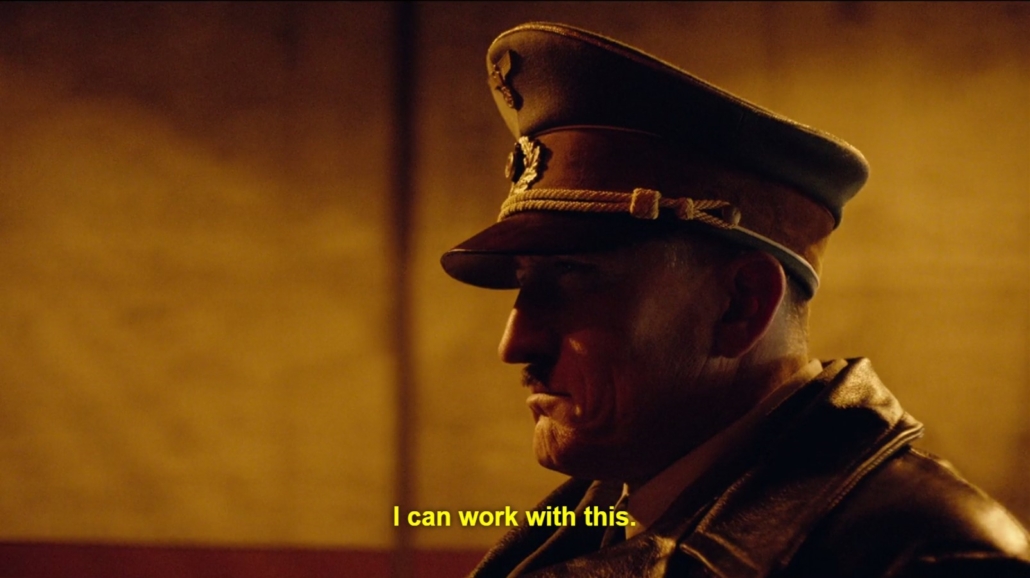
Hitler surveys the political scene in Europe, including the migrant crisis and rising nationalism.
The film ends with footage of contemporary rallies and audio clips of more or less nationalist statements from Germany and other European nations, all of which Hitler seems to approve. In another film, this is could be taken as an attempt to smear all nationalism as the reincarnation of Hitler and thus evil. But even here, the viewer cannot be certain that the creators did not honestly worry about the rise of a new Führer. Hitler observes all of this nationalist activity and says, “I can work with this;” the current situation is one which a new Führer would be able to take advantage of.
Considering the film overall, though, it could not have been meant as simply a crude condemnation of nationalism or populism. It is hard to imagine any self-respecting White man disagreeing with statements like “People who come to Sweden should adapt to our lifestyle.”
The type of people who would support such a charismatic leader today would not be only fringe figures making outlandish claims. They would be normal people expressing patriotic views that large numbers of Germans already agree with.
Further, no modern-day leader has been magicked into the present from the time of the Third Reich. We have no guarantee that the new nationalism will end in a lost World War and a suicide in a bunker. Considering the ongoing issues discussed in the film, Germans today have reason to hope for something very different.
Source: https://www.theoccidentalobserver.net/2021/04/04/look-whos-back/

